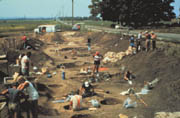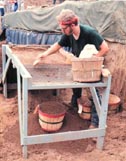
 |
||
 |
||
 |
Excavating Sites
Once a site has been located and surveyed, archaeologists must decide if the site should be explored further through excavation. To make this decision, they must answer certain questions:- Is the site in immediate danger of being destroyed (for example, is construction planned on the site)?
- Is this site likely to give information that will help answer the research questions the archaeologists are asking?
- Is there money available to fund the work?
 Working
as a Team
Working
as a Team
On site,
Museum archaeologists work in teams, or crews. Each member of the crew
has a specific responsibility during the excavation, ranging from organizing
the work schedule to caring for the tools and equipment. The type of land
at the site influences the methods the archaeologists will use. Sometimes,
heavy equipment (like a backhoe) is needed to move the top layers of dirt
and vegetation so that older sediment
is exposed. Flat-edged shovels may also be used for this purpose and to
create a flat ground surface.
Gridding
the Site
Excavations
are carefully planned, and mapping the excavation site is an important
part of the work. Often a geometric grid is laid out across the site using
string and stakes, and certain measured sections, called units, are selected
for excavation. Archaeologists document the coordinates (locations) of
these units (on special forms); how, when, and where each artifact
is found; and its surroundings.
 Digging
Digging
Most
of the crew spend long days digging in the sediment for remains of past
human activities. They use trowels,
brushes, and sometimes dental picks to do the more delicate work. Using
these tools and working close to the ground, archaeologists look for changes
in the sediment color and texture. They look for evidence of where dwellings
once stood and where tools were made, or even where ancient garbage was
disposed.
They recover artifacts and items such as stone tools, stone flakes, and broken pieces of pottery (sherds) and record them on maps, in field notes, and in drawings and photographs. Later, in the laboratory, other archaeologists can use this information to help put together a picture of the past.
 Screening
and Flotation
Screening
and Flotation
After
they document
the characteristics of the sediment and artifacts in a layer, archaeologists
continue to dig to find more clues about the people who lived there. The
removed sediment is carefully sifted or washed through a screen to recover
small remains such as flakes of stone, nuts, and animal bones.
Samples of sediment are saved for another process called flotation. During this process, the sediment is gently washed through fine-mesh screens while in a larger containter to recover tiny remains like seeds, snails, rodent bones, and very small stone flakes that float to the surface.
When studied together, these items give archaeologists a sense of what ancient environments and climates were like and what sorts of food people ate. The remains collected are brought back to the laboratory for study.
|
|
Copyright© 2000 Illinois State Museum Society